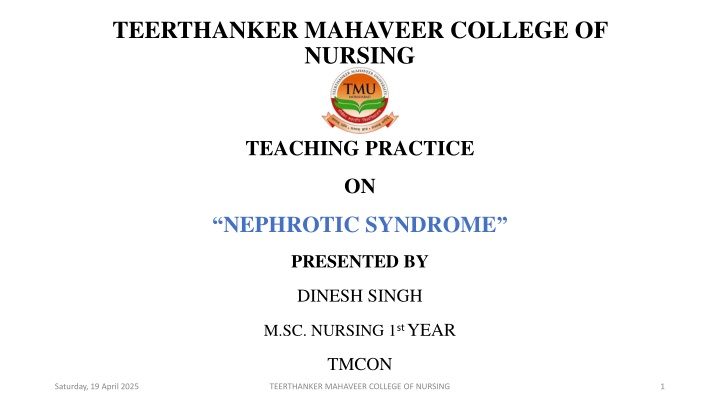
Nephrotic Syndrome: Causes, Symptoms & Treatment
Learn about nephrotic syndrome, a kidney disorder causing proteinuria, hypoalbuminemia, and hyperlipidemia. Explore its definition, causes, pathophysiology, and more. Join us at Teerthanker Mahaveer College of Nursing teaching practice session on Saturday, 19 April 2025.
Download Presentation

Please find below an Image/Link to download the presentation.
The content on the website is provided AS IS for your information and personal use only. It may not be sold, licensed, or shared on other websites without obtaining consent from the author. If you encounter any issues during the download, it is possible that the publisher has removed the file from their server.
You are allowed to download the files provided on this website for personal or commercial use, subject to the condition that they are used lawfully. All files are the property of their respective owners.
The content on the website is provided AS IS for your information and personal use only. It may not be sold, licensed, or shared on other websites without obtaining consent from the author.
E N D
Presentation Transcript
TEERTHANKER MAHAVEER COLLEGE OF NURSING TEACHING PRACTICE ON NEPHROTIC SYNDROME PRESENTED BY DINESH SINGH M.SC. NURSING 1st YEAR TMCON Saturday, 19 April 2025 TEERTHANKER MAHAVEER COLLEGE OF NURSING 1
NEPHROTIC SYNDROME Saturday, 19 April 2025 TEERTHANKER MAHAVEER COLLEGE OF NURSING 2
INTRODUCTION Nephrotic syndrome is a kidney disorder that causes the body to pass too much protein in the urine. Nephrotic syndrome is usually caused by damage to the clusters of small blood vessels in the kidneys that filter waste and excess water from the blood. Saturday, 19 April 2025 TEERTHANKER MAHAVEER COLLEGE OF NURSING 3
DEFINITION Nephrotic syndrome is a clinical disorder characterized by marked increase of protein in the urine (proteinuria), decrease in albumin in the blood (hypoalbuminemia), edema and excess lipids in the blood (hyperlipidemia). Nephrotic syndrome is characterized by the loss of plasma protein, particularly albumin, in the urine. Saturday, 19 April 2025 TEERTHANKER MAHAVEER COLLEGE OF NURSING 4
Saturday, 19 April 2025 TEERTHANKER MAHAVEER COLLEGE OF NURSING 5
CAUSES Auto immune reaction due to antigen Antibody reaction Streptococcal infection Renal disorders Drugs/toxins, eg. D-penicillin or captopril. Saturday, 19 April 2025 TEERTHANKER MAHAVEER COLLEGE OF NURSING 6
PATHOPHYSIOLOGY Due to inflammation of glomerular capillaries Abnormal permeability of glomerular basal membrane Then protein (albumin) is filtrate in urine (proteinuria) Decrease serum albumin level (hypoalbuminemia) Liver synthesis more lipo-protein (triglycerides) Saturday, 19 April 2025 TEERTHANKER MAHAVEER COLLEGE OF NURSING 7
Hyperlipidemia Due to albumin decrease in blood, oncotic pressure in blood vessels also decrease. So, fluid come out to extracellular space Oedema Saturday, 19 April 2025 TEERTHANKER MAHAVEER COLLEGE OF NURSING 8
CLINICAL MANIFESTATION Four main symptoms of nephrotic syndrome 1. Proteinuria:- the presence of abnormal quantities of protein in the urine. 2. Hypoalbuminemia:- when you don't have enough of the protein albumin in the bloodstream. 3. Hyperlipidemia:- increase amount of circulating fatty acids, triglycerides and cholesterol. 4. Oedema:- accumulation of fluid in subcutaneous tissue. Saturday, 19 April 2025 TEERTHANKER MAHAVEER COLLEGE OF NURSING 9
OTHER SYMPTOMS Shortness of breath Mild headache Weakness Anorexia (loss of appetite) Weight gain Irritability Hypertension Saturday, 19 April 2025 TEERTHANKER MAHAVEER COLLEGE OF NURSING 10
DIAGNOSTIC EVALUATION 1. Urine test A urinalysis can reveal abnormalities in the urine, such as large amounts of proteins. You might be asked to collect urine samples over 24 hours. 2. Blood test A blood test can show low levels of the protein albumin and often decreased levels of blood proteins overall. Loss of albumin is often associated with an increase in blood cholesterol and blood triglycerides. The creatinine and urea nitrogen levels in the blood also might be measured to assess the overall kidney function. Saturday, 19 April 2025 TEERTHANKER MAHAVEER COLLEGE OF NURSING 11
CONTI 3. Kidney biopsy Your doctor might recommend removing a small sample of kidney tissue for testing. During a kidney biopsy, a needle is inserted through the skin and into the kidney. Kidney tissue is collected and send a lab for testing. Saturday, 19 April 2025 TEERTHANKER MAHAVEER COLLEGE OF NURSING 12
Saturday, 19 April 2025 TEERTHANKER MAHAVEER COLLEGE OF NURSING 13
MEDICAL MANAGEMENT 1. Blood pressure medications Drug called angiotensin-converting enzyme (ACE) inhibitors reduce blood pressure and the amount of protein released in urine. Medications in this category include Lisinopril (prinvil, qbrelis, Zestril) Benzepril (Lotensin) Captopril and enalapril (Vasotec) Saturday, 19 April 2025 TEERTHANKER MAHAVEER COLLEGE OF NURSING 14
CONTI 2. Diuretics Control swelling by increasing your kidneys fluid output diuretic medications typically include furosemide (Lasix). 3. Cholesterol-reducing medications Statins are a group of medicines that can help lower the level of low-density lipoprotein (LDL) cholesterol in the blood. LDL cholesterol is often referred to as "bad cholesterol", and statins reduce the production of it inside the liver. Eg. Atorvastatin (Lipitor), Lovastatin (Altoprev). Saturday, 19 April 2025 TEERTHANKER MAHAVEER COLLEGE OF NURSING 15
CONTI 4. Blood thinners (anticoagulants) These might be prescribed to decrease the blood s ability to clot, especially if patient have a blood clot. Eg. Anticoagulants includes Heparin, Warfarin, Dabigatran, Apixaban. 5. Immune system suppressing medications Medication to control the immune system, such as corticosteroids, can decrease the inflammation that accompanies some of the conditions that can cause nephrotic syndrome medications include rituximab (Rituxan) cyclosporine and cyclophosphamide. Saturday, 19 April 2025 TEERTHANKER MAHAVEER COLLEGE OF NURSING 16
DIETARY MANAGEMENT Provide high protein and high carbohydrates diet to patient. In condition of oedema, no restriction of diet. If disease in advance stage then avoid protein intake because it is affected to kidney. Saturday, 19 April 2025 TEERTHANKER MAHAVEER COLLEGE OF NURSING 17
NURSING MANAGEMENT Assessment Find the cause of nephritis Assess skin integrity Assess fluid volume level Assess kidneys functions Saturday, 19 April 2025 TEERTHANKER MAHAVEER COLLEGE OF NURSING 18
NURSING DIAGNOSIS 1. Risk for infection related to immunosuppressive drugs. 2. Fluid and electrolyte imbalanced related to oedema. 3. Impaired skin integrity related to disease process. 4. Altered nutrition related to anorexia. 5. Altered kidney function related to disease condition. 6. Knowledge deficit related to disease process. Saturday, 19 April 2025 TEERTHANKER MAHAVEER COLLEGE OF NURSING 19
REFERENCE Lwis. Dirksen. Heitkemper. Textbook of medical surgical nursing, second south asia edition, volume1. page no. Brunner and suddarth s textbook of medical surgical nursing 13th south Asian edition, volume 2 page no. 1532 to 1533. Saturday, 19 April 2025 TEERTHANKER MAHAVEER COLLEGE OF NURSING 20
Saturday, 19 April 2025 TEERTHANKER MAHAVEER COLLEGE OF NURSING 21




